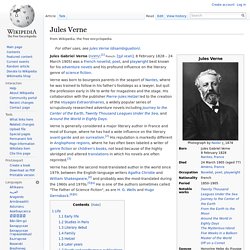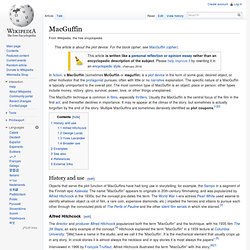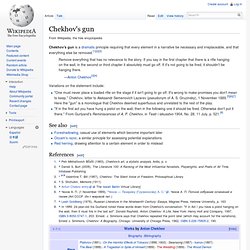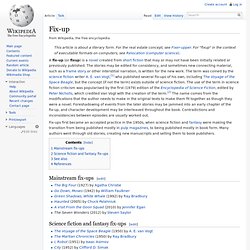

How to Write a Screenplay: Script & Screenwriting Tips. By Mario O.

Moreno and Kay Tuxford It's easy to feel intimidated by the thought of writing a screenplay. The rules! Catch-22. Catch-22 is a satirical novel by the American author Joseph Heller.

He began writing it in 1953; the novel was first published in 1961. It is set during World War II from 1942 to 1944. Dune (franchise) TV Tropes. Economist Robin Hanson, inspired by a scholarly analysis of Victorian literature,[6] suggests TV Tropes offers a veritable treasure trove of information about fiction - a prime opportunity for research into its nature.[7] Informality[edit] Article Organization[edit] The site includes entries on various series and tropes.

How To Write A Movie (screenplay) - The Visual Writer. How To Series.

Jules Verne. Jules Gabriel Verne (/vɜrn/;[1] French: [ʒyl vɛʁn]; 8 February 1828 – 24 March 1905) was a French novelist, poet, and playwright best known for his adventure novels and his profound influence on the literary genre of science fiction.

Verne was born to bourgeois parents in the seaport of Nantes, where he was trained to follow in his father's footsteps as a lawyer, but quit the profession early in life to write for magazines and the stage. His collaboration with the publisher Pierre-Jules Hetzel led to the creation of the Voyages Extraordinaires, a widely popular series of scrupulously researched adventure novels including Journey to the Center of the Earth, Twenty Thousand Leagues Under the Sea, and Around the World in Eighty Days. Literary technique. A literary technique (also known as literary device) is any method an author uses to convey his or her message.[1] This distinguishes them from literary elements, which exist inherently in literature.

Literary techniques pertaining to setting[edit] Literary techniques pertaining to plots[edit] Literary techniques pertaining to narrative perspective[edit] Retroactive continuity. MacGuffin. In fiction, a MacGuffin (sometimes McGuffin or maguffin) is a plot device in the form of some goal, desired object, or other motivator that the protagonist pursues, often with little or no narrative explanation.

The specific nature of a MacGuffin is typically unimportant to the overall plot. The most common type of MacGuffin is an object, place or person; other types include money, victory, glory, survival, power, love, or other things unexplained. History and use[edit] Alfred Hitchcock[edit] Interviewed in 1966 by François Truffaut, Alfred Hitchcock illustrated the term "MacGuffin" with this story:[6][7] Plot twist. Chekhov's gun. Chekhov's gun is a dramatic principle requiring that every element in a narrative be necessary and irreplaceable, and that everything else be removed.[1][2][3] Remove everything that has no relevance to the story.

If you say in the first chapter that there is a rifle hanging on the wall, in the second or third chapter it absolutely must go off. If it's not going to be fired, it shouldn't be hanging there. Variations on the statement include: "One must never place a loaded rifle on the stage if it isn't going to go off. Suspension of disbelief. Suspension of disbelief or willing suspension of disbelief is a term coined in 1817 by the poet and aesthetic philosopher Samuel Taylor Coleridge, who suggested that if a writer could infuse a "human interest and a semblance of truth" into a fantastic tale, the reader would suspend judgement concerning the implausibility of the narrative.

Suspension of disbelief often applies to fictional works of the action, comedy, fantasy, and horror genres. Cognitive estrangement in fiction involves using a person's ignorance or lack of knowledge to promote suspension of disbelief. The phrase "suspension of disbelief" came to be used more loosely in the later 20th century, often used to imply that the burden was on the reader, rather than the writer, to achieve it. This might be used to refer to the willingness of the audience to overlook the limitations of a medium, so that these do not interfere with the acceptance of those premises.
Coleridge's original formulation[edit] Fix-up. Fix-ups first became an accepted practice in the 1950s, when science fiction and fantasy were making the transition from being published mostly in pulp magazines, to being published mostly in book form.

Many authors went through old stories, creating new manuscripts and selling them to book publishers. Mainstream fix-ups[edit] Science fiction and fantasy fix-ups[edit] The Bicentennial Man. According to the foreword in Robot Visions, Asimov was approached to write a story titled "Bicentennial Man" for a science fiction collection, along with a number of other authors who would do the same, in honor of the bicentennial of the United States.
However, the arrangement fell through, leaving Asimov's the only story actually completed for the project. Asimov sold the story to Judy-Lynn del Rey, who made some small changes to the text. Robot series (Asimov) The Robots of Dawn (1983) The Robot series is a series of short stories and novels by science fiction author Isaac Asimov (1920-1992) featuring positronic robots. Foundation series. Publication history[edit] Original stories[edit] Foundation trilogy[edit] Screenwriting.info: How to Write a Screenplay. Auguste Villiers de l'Isle-Adam. Villiers de l'Isle-Adam Life[edit] Villiers de l'Isle-Adam was born in Saint-Brieuc, Brittany, to a distinguished aristocratic family. His parents, Marquis Joseph-Toussaint and Marie-Francoise (née Le Nepvou de Carfort) were not rich, however, and were financially supported by Marie's aunt, Mademoiselle de Kerinou.
His father became obsessed with the idea he could restore the family fortune by finding the lost treasure of the Knights of Malta (Philippe Villiers de L'Isle-Adam, 16th century Grand Master of the Knights Hospitaller, was his ancestor), which had reputedly been buried near Quintin during the French Revolution. The Future Eve. Characters[edit] Thomas EdisonLord EwaldAlicia, Ewald's fianceeHadaly, a mechanical woman constructed by EdisonSowana, Edison's mystical assistantMr.
Anderson, a former acquaintance of Edison'sMiss Evelyn, a young woman who seduces Mr. AndersonMrs. Anderson, Mr. Last and First Men. Last and First Men: A Story of the Near and Far Future is a "future history" science fiction novel written in 1930 by the British author Olaf Stapledon. Olaf Stapledon. Edgar Rice Burroughs. Peter F. Hamilton. Peter F. Hamilton (born 2 March 1960) is a British author. He is best known for writing space opera. Arthur C. Clarke. Isaac Asimov.
Robert A. Heinlein. Rendezvous with Rama. Rendezvous with Rama is a hard science fiction novel by Arthur C. Nebula Award for Best Novel. Frank Herbert. Dune (novel) Nebula Award. An Interactive Guide to NPR's List of Top 100 Science Fiction and Fantasy Books.